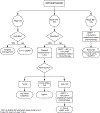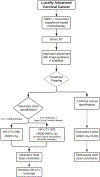Radiation Therapy for Cervical Cancer: Executive Summary of an ASTRO Clinical Practice Guideline
- PMID: 32473857
- PMCID: PMC8802172
- DOI: 10.1016/j.prro.2020.04.002
Radiation Therapy for Cervical Cancer: Executive Summary of an ASTRO Clinical Practice Guideline
Abstract
Purpose: This guideline reviews the evidence and provides recommendations for the indications and appropriate techniques of radiation therapy (RT) in the treatment of nonmetastatic cervical cancer.
Methods: The American Society for Radiation Oncology convened a task force to address 5 key questions focused on the use of RT in definitive and postoperative management of cervical cancer. These questions included the indications for postoperative and definitive RT, the use of chemotherapy in sequence or concurrent with RT, the use of intensity modulated radiation therapy (IMRT), and the indications and techniques of brachytherapy. Recommendations were based on a systematic literature review and created using a predefined consensus-building methodology and system for grading evidence quality and recommendation strength.
Results: The guideline recommends postoperative RT for those with intermediate risk factors, and chemoradiation for those with high-risk factors. In the definitive setting, chemoradiation is recommended for stages IB3-IVA, and RT or chemoradiation is conditionally recommended for stages IA1-IB2 if medically inoperable. IMRT is recommended for postoperative RT and conditionally recommended for definitive RT, for the purposes of reducing acute and late toxicity. Brachytherapy is strongly recommended for all women receiving definitive RT, and several recommendations are made for target dose and fractionation, the use of intraoperative imaging, volume-based planning, and recommendations for doses limits for organs at risk.
Conclusions: There is strong evidence supporting the use of RT with or without chemotherapy in both definitive and postoperative settings. Brachytherapy is an essential part of definitive management and volumetric planning is recommended. IMRT may be used for the reduction of acute and late toxicity. The use of radiation remains an essential component for women with cervical cancer to achieve cure.
Copyright © 2020 American Society for Radiation Oncology. Published by Elsevier Inc. All rights reserved.
Figures



Comment in
-
Reports From Four International Clinical Trials for Cancers of the Cervix, Uterus and Vulva, and a New Guideline for Cervical Cancer.Int J Radiat Oncol Biol Phys. 2021 Oct 1;111(2):299-306. doi: 10.1016/j.ijrobp.2021.05.002. Int J Radiat Oncol Biol Phys. 2021. PMID: 34473967 No abstract available.
References
-
- Peters WA, Liu PY, Barrett RJ, et al. Concurrent chemotherapy and pelvic radiation therapy compared with pelvic radiation therapy alone as adjuvant therapy after radical surgery in high-risk early-stage cancer of the cervix. J Clin Oncol 2000;18:1606–1613. - PubMed
-
- Qin AQ, Liang ZG, Ye JX, et al. Significant efficacy of additional concurrent chemotherapy with radiotherapy for postoperative cervical cancer with risk factors: A systematic review and meta-analysis. Asian Pac J Cancer Prev 2016;17:3945–3951. - PubMed
-
- Yang J, Yin J, Yan G, Huang D, Wang J. Postoperative chemoradiotherapy versus radiotherapy alone for cervical cancer: A systematic review and meta-analysis. J Obstet Gynaecol 2016;36: 641–648. - PubMed
-
- Sedlis A, Bundy BN, Rotman MZ, Lentz SS, Muderspach LI, Zaino RJ. A randomized trial of pelvic radiation therapy versus no further therapy in selected patients with stage IB carcinoma of the cervix after radical hysterectomy and pelvic lymphadenectomy: A Gynecologic Oncology Group Study. Gynecol Oncol 1999;73:177–183. - PubMed
Publication types
MeSH terms
Grants and funding
LinkOut - more resources
Full Text Sources
Other Literature Sources
Medical

